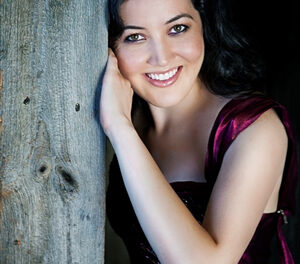Music Director John Gordon Ross and his band of merry ladies and men had the First Baptist Church rockin’ for the Western Piedmont Symphony‘s fourth masterworks concert of the season.
The Overture to La Gazza Ladra (The Thieving Magpie) by Gioacchino Rossini (1792-1868) started the festivities. Rossini, who dearly loved a joke, startles his audience by opening with two drum rolls, unusual for the time, and then proceeds into one of the most brashly self-confident marches ever written, and, indeed, it was played with boldness and exuberance. This leads into a light and lightening fast section, in which the strings played in perfect synchrony and harmony. Then the final theme comes along, starting out at a rather sedate pace and dynamic, only to build in speed and volume, then adding the famous “Rossini crescendo,” not once, but twice! And this only loosened the rafters.
Terra Terribilis, a concerto for three percussionists and orchestra, by Laura Kaminsky (born 1956), shook the roof. This was only the second performance of this work; the world premier having taken place in April, 2008. The composer has said that “Terra Terribilis is a musical outcry against the despoliation of our planet, and a plea for vigilance and reparation.”
The first movement, “Exuberant Earth,” opens with a cadenza featuring the three solo percussionists – Michael Filip, Rick Cline, and Charles Smith – playing together until they are finally joined by the orchestra. The three middle movements provide solo opportunities for each, with “Glacier” featuring the drums (Michael Filip), “Ozone” the metal instruments (Charles Smith), and “Fauna” the marimba (Rick Cline). The final movement, “Enduring Earth,” is a grand finale, again utilizing a cadenza with the soloists, with Kyle Wilkerson assisting on the marimba.
Needless to say, this was a very difficult work to perform, both for the soloists and the orchestra, all of whom executed it with great virtuosity. Thanks to a grant from “Meet the Composer, Inc.”, Ms. Kaminsky was able to be present, as was her partner, Rebecca Allan, to whom this performance was dedicated.
The culmination of the evening was Peter Ilich Tchaikovsky’s (1840-1893) Symphony No. 5 in E minor, Op. 64. This symphony expresses Tchaikovsky’s complete resignation to his fate. “Fate” is a motto theme which appears in all four movements. The first movement, where this theme is introduced, is darkly brooding and despairing. The romantic second movement is based on a lovely starlit theme which is interrupted twice by the Fate theme. The third movement is a waltz based on an Italian street song Tchaikovsky had heard years before. It, too, ends with the Fate motto. The finale opens with the Fate theme, but this time in a glorious transformation and it keeps returning each time grander, louder, and longer. By the end, the roof has been blown off the building!
A lack of space prevents singling out any individual performance, which would require listing each of the sixty members of the orchestra by name. Their playing was hot and their energy was palpable. The audience recognized this, too, and responded with like enthusiasm.











